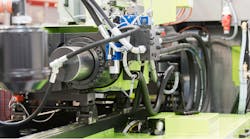I was called out to troubleshoot a small injection molding machine that had been made in Japan about 20 years earlier. As is often the case, very little documentation was available. The problem was that circuit pressure would not go high enough to signal that clamp tonnage had been reached. As a result, the machine did not execute the next two steps of its operating cycle.
The clamp desired pressure was set on the pump’s compensator. In this case, the clamp pressure was set at 3,000 psi, but system pressure would only reach about 1,800 psi. All the valves were mounted onto a single manifold. The machine also had a solenoid-operating unloading safety relief, but I don’t know why it was needed.
The hydraulic pump had been replaced, and the clamp cylinder had been rebuilt. The operators told me the system was very dirty because someone had removed the filter element, so the machine ran for months with no filter. Technicians also removed the unloading valve head to ensure the control orifice was clear; all parts were free moving, and the bias spring was not broken.
So what do you think prevented the machine from achieving full pressure?
Find the Solution
Think you know the answer to this month’s problem? Submit your solution by emailing [email protected]. All correct solutions submitted by Sept. 6, 2017, will be entered into a random drawing for a $50 gift card. The winner will be notified, and his or her name will be printed in a future issue. Only one gift card will be awarded to any participant within a calendar year.
Solution to Last Month’s Challenge:
No Pressure on a Simple System
A system that loses all pressure typically is caused by the control orifice of a pilot-operated pressure control being plugged. I disassembled the relief valve and found the main poppet had opened and varnish deposits had lodged in the open position. This was a balanced poppet, so a bias spring is the main force closing it.
When the mechanics inspected the valve, they didn’t realize the main poppet was supposed to move. They had found the problem but didn’t recognize it. This is a perfect example of where some hands-on training would’ve paid off big.



